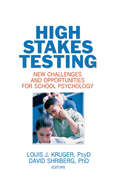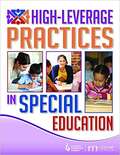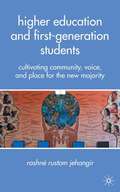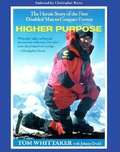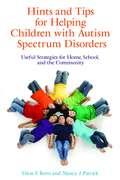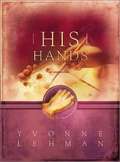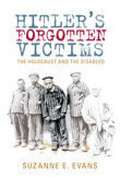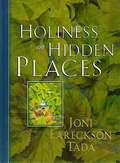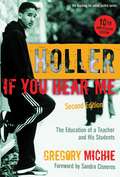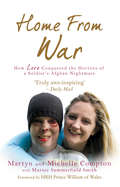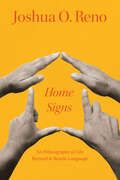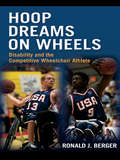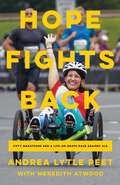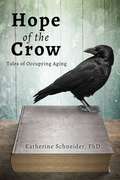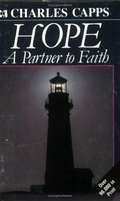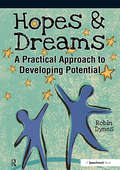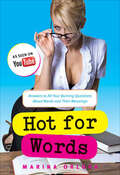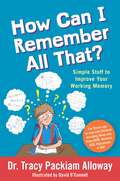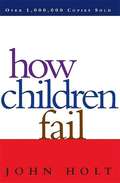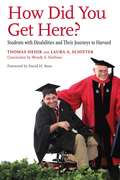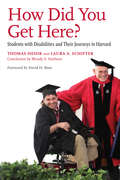- Table View
- List View
High Stakes Testing: New Challenges and Opportunities for School Psychology
by David Shriberg Louis J. KrugerMeet the challenges of high stakes testing in the practice of school psychology School psychologists can be a positive influence on how students, teachers, parents, schools, and communities cope with the challenges and opportunities associated with high stakes testing. Unfortunately, there has been a significant lack of literature to guide school psychologists and related school-based practitioners on this topic. High Stakes Testing: New Challenges and Opportunities for School Psychology is a timely groundbreaking book that provides useful and thought-provoking information to help psychologists meet the challenges of high stakes testing and create new roles for themselves in helping children succeed. This book discusses practical ways to help provide academic support to facilitate student success on high stakes tests, reduce the impact of stress associated with high stakes testing, assess the data from the tests to improve programs, and take a leadership role in the appropriate use of the tests. The No Child Left Behind Act of 2001(NCLB) and its accountability provisions has helped create and sustain a climate where student performance on state-created achievement tests often has high stakes implications for students, families, and schools. High Stakes Testing: New Challenges and Opportunities for School Psychology provides important background information about high stakes testing, including the legal, historical, and political context of high stakes testing, pertinent psychometrics, and a review of research on academic and non-academic outcomes as it relates to high stakes testing. Using this information as a foundation, the book then identifies new roles and opportunities for school psychologists with respect to high stakes testing. This book is comprehensively referenced. Topics in High Stakes Testing: New Challenges and Opportunities for School Psychology include: advocating for the appropriate use of state-wide assessments the influence of item response theory (IRT) on the development of high stakes tests whether the accountability system of NCLB is truly improving student&’s learning the impact of high stakes tests on classroom instruction and student motivation strategies for helping students succeed on high stakes tests available resources to cope with the stress of high stakes testing and more High Stakes Testing: New Challenges and Opportunities for School Psychology is a thought-provoking, horizon-expanding resource for school psychologists, public school educators, administrators, school counselors, curriculum coordinators, and special education teachers involved in organizing, administering, and preparing students to take high stakes tests.
High-Leverage Practices In Special Education: The Final Report of the HLP Writing Team
by Council for Exceptional Children Ceedar CenterSpecial education teachers, as a significant segment of the teaching profession, came into their own with the passage of Public Law 94-142, the Education for All Handicapped Children Act, in 1975. Since then, although the number of special education teachers has grown substantially it has not kept pace with the demand for their services and expertise. The roles and practice of special education teachers have continuously evolved as the complexity of struggling learners unfolded, along with the quest for how best to serve and improve outcomes for this diverse group of students. High-Leverage Practices in Special Education defines the activities that all special educators needed to be able to use in their classrooms, from Day One. HLPs are organized around four aspects of practice collaboration, assessment, social/emotional/behavioral practices, and instruction because special education teachers enact practices in these areas in integrated and reciprocal ways. The HLP Writing Team is a collaborative effort of the Council for Exceptional Children, its Teacher Education Division, and the CEEDAR Center; its members include practitioners, scholars, researchers, teacher preparation faculty, and education advocates.
Higher Education and Disabilities: International Approaches
by Alan HurstThe subject of disabled students in universities has been overlooked in educational research. Building on the content of his first book "steps towards graduation" Alan Hurst has worked with colleagues from overseas to compile a collection of papers which explore aspects of policy and provision for this important student minority. The book contains accounts from Australia and North America as well as countries at different stages of policy development in Europe. The book should be of interest to staff working with students with disabilities in post-compulsory education since it describes strategies for developing policy, which could be transferable to other contexts. The book will be especially useful for those involved in promoting opportunities for study abroad. It will also be relevant to those engaged in researches in special education, comparative education and educational policy as well as in the growing area of disability studies.
Higher Education and First-Generation Students
by Rashné Rustom JehangirOffers readers a rich understanding of the experience of students who are first in their family to attend college. This book is a theoretically informed study of the lived experience of FG students and draws on their voices to demonstrate how their insights interface with what we, as educators, think we know about them.
Higher Purpose: Heroic Story of the First Disabled Man to Conquer Everest
by Johnny Dodd Tom WhittakerAs Tom Whittaker struggled to keep conscious the night of 27 November 1979, his thoughts focused on a singular plea: Please, don't let them take my legs. Earlier that evening, a drunk driver struck Tom's VW van on an isolated, snow-covered road in Idaho and shattered his legs -- and his dreams. When he awoke from emergency surgery, the 31-year-old mountaineer's right leg had been amputated at mid-shin and his right kneecap removed. Devastated, he pondered suicide. Finally it occurred to him: you don't need your lower leg to kayak. Seven months after the accident, Tom hobbled down to the south fork of the Payette River, and began paddling. In the years since then, Tom has not only taken his life back, he's taken his family, his fellow sportsmen, and hundreds of thousands of disabled and able-bodied people to the top of the world. In May 1998, Tom became the first amputee to summit Mount Everest. The climb and his inspirational story, as well as his work on behalf of disabled people around the world, have earned him the recognition as one of America's most courageous heroes.
Hints and Tips for Helping Children with Autism Spectrum Disorders: Useful Strategies for Home, School, and the Community
by Dion Betts Nancy J PatrickIf you have a child on the autism spectrum who struggles with the challenges of daily life, then this book is for you! Hints and Tips... is peppered with vignettes and stories of real-life situations and successes, and offers clever ideas for tackling everyday difficulties, such as bathing, bedtime, school trips, and selecting the right child minder. Dion E. Betts and Nancy J. Patrick provide creative, practical strategies to help parents and caregivers to support their child, and to enable their child to develop the social skills needed to manage and enjoy daily life to the fullest. The book is split into five parts: home life, hygiene, community, medical, and schools and organizations. Common problem areas are also tackled in a toolkit section, which includes checklists, 'to do' lists, visual schedules, and mnemonics to aid memory and retrieval. Hints and Tips for Helping Children with Autism Spectrum Disorders is an essential aid for parents and carers to make small and simple changes that result in big improvements in the quality of life of children, their families, and carers.
His Hands
by Yvonne LehmanMatthew MacEwen finds the Blue Ridge Mountains a peaceful perfect home for an artist. . .until the day a plane crash destroys his calm. While pulling a young girl from the blazing wreckage, he irreparably scars his hands-and his future. When she is pronounced dead, can Matthew find a reason to go on? Sixteen-year-old Christine Norwood nearly died in the burning wreckage. . .even after a courageous young man intervened. She, too, is left with emotional scars and longs to find the man who gave her a second chance. When she does find him, six years later, Christine sees not a victorious hero but a man as turbulent as the waters ' ' of the Nantahala River. Does she dare identify herself to this broken artist, whose life was shattered by his brave deed? If Christine reveals her past to Matthew, how will he respond? Will he reject her? Or might the two find hope to overcome their fiery trials together? The Veteran novelist lives in the heart of North Carolina's Blue Ridge Mountains. The founder of the Blue Ridge Christian Writers Conference, she is the recipient of numerous /awards, including The Dwight L Moody Award for Excellence in Christian Literature as well as The National Reader's Choice and Booksellers' Best awards from the Romance Writers of America.
Hitler's Forgotten Victims: The Holocaust and the Disabled
by Suzanne EvansBetween 1939 and 1945, the Nazi regime systematically murdered hundreds of thousands of children and adults with disabilities as part of its 'euthanasia' policy. These programs were designed to eliminate all persons with disabilities who, according to Nazi ideology, threatened the health and purity of the German race. Hitler's Forgotten Victims explores the development and workings of this nightmarish process, a relatively neglected aspect of the Holocaust. Suzanne Evans's account draws on the rich historical record as well as scores of exclusive interviews with disabled Holocaust survivors. It begins with a description of the Nazis' Children's Killing Program, in which tens of thousands of children with mental and physical disabilities were murdered by their physicians, usually by starvation or lethal injection. The book goes on to recount the T4 euthanasia program, in which adults with disabilities were disposed of in six official centers, and the development of the Sterilization Law that allowed the forced sterilization of at least a half-million young adults with disabilities.
Holiness in Hidden Places
by Joni Eareckson TadaThrough a series of devotions, Joni helps us to focus on the every day situations that show us "Holiness in Hidden Places."
Holler If You Hear Me: The Education of a Teacher and His Students (2nd Edition)
by Gregory MichieIn this time of narrowed curricula and high-stakes accountability, Gregory Michie's tales of struggle and triumph in Holler If You Hear Me: The Education of a Teacher and His Students are as relevant as ever. Since it was first published in 1999, Holler has become essential reading for new and seasoned teachers alike, and is an inspiring read for others. Weaving back and forth between Michie's awakening as a teacher and the first-person stories of his students, this highly acclaimed book paints an intimate and compassionate portrait of teaching and learning in urban America. While the popular notion of what it's like to teach in urban schools is one dominated by horror stories and hero tales, Michie and his students reside somewhere between these extremes, "between the miracles and the metal detectors. "
Holy Enchilada! (Hank Zipzer, the World's Greatest Underachiever #6)
by Henry Winkler Lin OliverPS 87 is having multicultural week, and Ms. Adolf's class is putting on a "Foods from Around the World" luncheon. Hank is thrilled--no reading, no outlining, and no review questions, just cooking! Hank makes enchiladas, and at the luncheon, Ms. Adolf piles her plate with lots of food. But after a few bites, her face turns bright red--one of the dishes is super-spicy! Ms. Adolf accuses someone of playing a mean practical joke, and punishes the entire class with no recess until the guilty party comes forward. Hank realizes his trouble with numbers might have caused the problem--what if he accidentally used three cups of peppers instead of 1/3 cup? Will Hank be able to get recess back for everyone without getting detention for the rest of his life?
Home From War: How Love Conquered the Horrors of a Soldier's Afghan Nightmare
by Marnie Summerfield Smith Martyn Compton Michelle ComptonLance Corporal Martyn Compton's life was changed beyond recognition when he was blown up in a Taliban ambush that killed three of his colleagues. His survival was described as a 'miracle', as he suffered third-degree burns to 75 per cent of his body. He endured 15 operations and doctors used shark cartilage as a base for new skin on his face.But he did not have to face this gruelling ordeal alone. From the moment she heard of his near-fatal wounds, Martyn's fiancée Michelle Clifford found an inner strength to help them both face the future. During Martyn's treatment, Michelle kept a diary in which she revealed the innermost thoughts and emotions she wished she could relay to her wounded partner.Home From War gives a rare insight into the story behind the headlines when soldiers die or are injured. It is also the account of Martyn's battle for adequate compensation. This exploration of how one courageous man came to terms with losing his handsome young face cannot fail to inspire.
Home Signs: An Ethnography of Life beyond and beside Language
by Joshua O. RenoAn intimate account of an anthropologist’s relationship with his non-verbal son and how it has shaped and transformed his understanding of closeness and communication. Home Signs grew out of the anthropologist Joshua Reno’s experience of caring for and trying to communicate with his teenage son, Charlie, who cannot speak. To manage interactions with others, Charlie uses what are known as “home signs,” gestures developed to meet his need for expression, ranging from the wiggle of a finger to a subtle sideways glance. Though he is nonverbal, he is far from silent: in fact, he is in constant communication with others. In this intimate reflection on language, disability, and togetherness, the author invites us into his and Charlie’s shared world. Combining portraits of family life and interviews with other caregivers, Reno upends several assumptions, especially the idea that people who seem not to be able to speak for themselves need others to speak on their behalf. With its broad exploration of nonverbal communication in both human and nonhuman contexts, Home Signs challenges us to think harder about what it means to lead a “normal” life and to connect with another person.
Honey Out of Stone
by Gary AdelmanGary Adelman has written intensely about a man's rediscovery of life within the affliction of unexpected blindness. Attacked by diabetes-induced blindness, Ben Storch abides the despair attendant upon the dissolution of his marriage and the spiritual terror of darkness. It is an "unblinding" through love--the love of a childhood sweetheart who leaves her own unhappy marriage to come to him--that gives his life an unhoped-for new meaning. Adelman tells Storch's story in a blend of prose and poetry which ranges from lyric and tender to violent and grotesque. He captures the heartbreak of loss and then the exhilaration of spiritual rebirth. But the essence of the book is his lyric, sexual, and wildly exuberant celebration of the romantic love, which has brought him new joy, new strength and vision.
Hoop Dreams on Wheels: Disability and the Competitive Wheelchair Athlete (Sociology Re-Wired)
by Ronald BergerHoop Dreams on Wheels is a life-history study of wheelchair athletes associated with a premier collegiate wheelchair basketball program. The book, which grapples with the intersection of biography and history in society, situates the study in broader context with background on the history and sociology of disability and disability sports. It documents the development and evolution of the basketball program and tells the individual life stories of the athletes, highlighting the formative interpersonal and institutional experiences that influenced their agentive actions and that helped them achieve success in wheelchair sports. It also examines divisions within the disability community that reveal both empowering and disempowering aspects of competitive wheelchair athletics, and it explores some of the complexities and dilemmas of disability identity in contemporary society. The book is intended to be read by a general audience as well as by students in college courses on disability, sports, social problems, deviance, medical sociology and anthropology, and introductory sociology. It also will be of interest to scholars in the sociology of disability, sociology of sports, and medical humanities, as well as life-history researchers and professionals in the fields of physical education, therapeutic recreation, and rehabilitative counseling.
Hope Fights Back: Fifty Marathons and a Life or Death Race Against ALS
by Andrea Lytle PeetThe incredible story of a young woman living with ALS, who defies all odds by finishing fifty marathons and, in turn, inspires people to &“go on, be brave.&”Andrea Lytle Peet was thirty-three years old—an urban planner living in D.C., newly married, and a triathlete—when she received the death sentence of an ALS diagnosis (also known as Lou Gehrig's disease). After grappling with the fact that she will likely become paralyzed and die within two to five years, Andrea experienced an unexpected spark that changes her outlook in the most magnificent way. Inspired by Jon Blais, famous for finishing the IRONMAN World Championship while fighting the same disease, Andrea sets an "impossible" goal to become the first person with ALS to complete a marathon in all fifty U.S. states on her recumbent trike—since she is no longer able to run. In her mission, Andrea recaptures the freedom that racing always gave her and inspires others to appreciate what our bodies can do. Her mindset shifts to accepting that although she is dying faster than she might have otherwise, we are all on the same path. Andrea, along with her husband and ALS community, prove that we all have choices in how we spend our precious lives—no matter what challenges we face. Hope Fights Back chronicles what happens when we choose to live instead of waiting to die. It is a "love letter to life" and a beautiful love story between Andrea and her husband, David. Andrea&’s words are awe-inspiring for athletes and non-athletes alike. The reader intimately witnesses Andrea&’s tenacity, determination and bravery, not only in accomplishing her fifty marathons goal, but in her day-to-day life with ALS. In a world where &“hope&” sometimes feels quiet and aspirational, Andrea reveals that hope is, instead, a valiant warrior that changes everything when it fights back. In Hope Fights Back, readers will be empowered by Andrea's force as an athlete and a woman fighting the battle of her life. For readers of Until I Say Goodbye, Let Your Mind Run and Between Two Kingdoms, Hope Fights Back is a magnetic and radiant story filled with soul-baring honesty, love and true grit. A documentary about Andrea&’s triumphant journey, Go On, Be Brave, will premier at the 2023 Santa Barbara International Film Festival.
Hope of the Crow: Tales of Occupying Aging
by Katherine SchneiderWhen is the last time you've read an honest, funny book about occupying aging and living with disabilities? Katherine Schneider provides seven years of snap shots of the life of a grass-roots elder activist working, loving, playing, and praying with disabilities included. Half the people over sixty-five will develop a disability. 2020 is the thirtieth anniversary of the Americans with Disabilities Act, so we're in style! Read on to learn about occupying aging with grit and gusto.
Hope: A Partner To Faith
by Charles CappsThis is an exquisite devotional book which guides the Christian toward a richer faith in God. It is easy to read, compassionate, and inspiring. Consider:: "Remember: Faith and hope are partners and you need them both. Start where you are. Use some common sense. Operate on your level. Confess God's promises daily. Your faith will grow and your productivity will increase."
Hopes & Dreams - Developing Potential: A Practical Approach to Developing Potential
by Robin DynesThis practical resource provides the tools to help individuals explore their ambitions, set goals and plan to achieve them, manage their lives and gain the skills to make their hopes and dreams a reality. The programme is ideal for use with people who are making major changes in their lives and are ready to explore their options for the future. They may wish to return to education, go back to work, change jobs, start voluntary work, take up new interests or are considering other changes in their lives. The book is divided into two parts: six core sessions covering: Making a start, Deciding what you want, Setting goals, Making it happen, Learning to learn and What next? and Eight optional sessions. These can be used individually or added to the core sessions in any order, depending on identified need. The sessions cover: Dealing with stress, Coping with change, Being assertive, Overcoming relationship conflict, Organising your time, Dealing with disappointment, Keeping records and Creating an impression. It is an ideal resource for youth leaders, teachers, support workers, occupational therapists, social workers and probation staff. It has been developed through the experience of working with groups and individuals in adult education, youth services, day centres and rehabilitation centres.
Hot for Words: Answers to All Your Burning Questions About Words and Their Meanings
by Marina OrlovaBrilliant philologist and sexy YouTube sensation Marina Orlova is Hot For Words—and you will be too when you join her on a titillating journey through the origins and meanings of words and phrases. Combining fascinating philology and etymology with provocative, full-colored photos of the alluring author, Hot For Words makes intelligence almost unbearably sexy…and lots of fun!
How Can I Remember All That?: Simple Stuff to Improve Your Working Memory
by Tracy Packiam Packiam AllowayWhy can't I remember what my parents just asked me to do? Why do I feel stressed out at school when the teacher is writing on the board and talking at the same time? And what can I do about it? Working memory issues affect a huge proportion of kids with learning differences like ADHD, dyslexia, dyscalculia, and ASD. These issues can make them feel frustrated or bored, as working memory and intelligence are two very different things. Kids with working memory problems can also act out in the classroom and at home. In this child-friendly and authoritative guide, international working memory expert Dr Tracy Packiam Alloway walks you through what working memory is, what it feels like to have problems with your working memory, and what you can do about it. She presents key tips and strategies, such as the benefits of eating chocolate or of barefoot running, that will help children both at home and at school, and includes a section at the end for adults describing how we can test for working memory issues.
How Children Fail (Classics In Child Development Series)
by John HoltFirst published in the mid 1960s, How Children Fail began an education reform movement that continues today. <P><P>In his 1982 edition, John Holt added new insights into how children investigate the world, into the perennial problems of classroom learning, grading, testing, and into the role of the trust and authority in every learning situation. His understanding of children, the clarity of his thought, and his deep affection for children have made both How Children Fail and its companion volume, How Children Learn, enduring classics.
How Did You Get Here? Students with Disabilities and Their Journeys to Harvard
by Thomas Hehir Laura A. SchifterA compelling and practical book, How Did You Get Here? offers clear accounts not only of the challenges and biases facing young disabled students, but also of the opportunities they found, and created, on the way to academic and personal success.
How Did You Get Here?: Students with Disabilities and Their Journeys to Harvard
by David Rose Thomas Hehir Wendy S. Harbour Laura A. SchifterWhen their children were young, several parents interviewed in this book were told "you can't expect much from your child." As they got older, the kids themselves often heard the same thing: that as children with disabilities, academic success would be elusive, if not impossible, for them. How Did You Get Here? clearly refutes these common, destructive assumptions. It chronicles the educational experiences--from early childhood through college--of sixteen students with disabilities and their paths to personal and academic success at Harvard University. The book explores common themes in their lives--including educational strategies, technologies, and undaunted intellectual ambitions--as well as the crucial roles played by parents, teachers, and other professionals. Above all, it provides a clear and candid account--in the voices of the students themselves--of what it takes to grapple effectively with the many challenges facing young people with disabilities. A compelling and practical book, How Did You Get Here?offers clear accounts not only of the challenges and biases facing young disabled students, but also of the opportunities they found, and created, on the way to academic and personal success.
How Did You Get Here?: Students with Disabilities and Their Journeys to Harvard
by Thomas Hehir Wendy S. Harbour Laura A. SchifterWhen their children were young, several parents interviewed in this book were told &“you can&’t expect much from your child.&” As they got older, the kids themselves often heard the same thing: that as children with disabilities, academic success would be elusive, if not impossible, for them. How Did You Get Here? clearly refutes these common, destructive assumptions. It chronicles the educational experiences—from early childhood through college—of sixteen students with disabilities and their paths to personal and academic success at Harvard University. The book explores common themes in their lives—including educational strategies, technologies, and undaunted intellectual ambitions—as well as the crucial roles played by parents, teachers, and other professionals. Above all, it provides a clear and candid account—in the voices of the students themselves—of what it takes to grapple effectively with the many challenges facing young people with disabilities. A compelling and practical book, How Did You Get Here?offers clear accounts not only of the challenges and biases facing young disabled students, but also of the opportunities they found, and created, on the way to academic and personal success.
